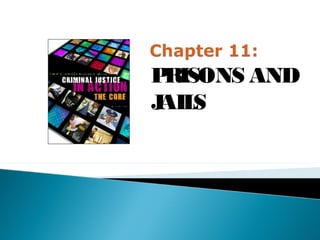
Chapter11
- 1. PRISONS AND J S AIL
- 2. William Penn’s “Great Law” ◦ Pennsylvania, 1682. ◦ Forbade corporal punishment, and envisioned prisons as workhouses. The Walnut Street Jail ◦ Philadelphia, 1890 ◦ Silence and labor are the keys to rehabilitation. ◦ Suffered from overcrowding and excessive costs.
- 3. Contrast the Pennsylvania and the New York penitentiary theories of the 1800s.
- 4. The Pennsylvania System The New York System Silence and in-cell labor Solitary confinement Constant solitary leads to insanity in confinement (the inmates separate system) Inmates are allowed to Only human contact is work together, while with visiting clergy maintaining silence (the congregate system)
- 6. The Reformers and the Progressives ◦ The “new penology” ◦ The medical model The Reassertion of Punishment
- 7. List the factors that have caused the prison population to grow dramatically in the last several decades.
- 9. Factors in prison growth: Enhancement and stricter enforcement of drug laws Increased probability of incarceration Inmates are serving more time for each crime Federal prison growth Rising incarceration rates of women
- 10. List and briefly describe the four types of prisons.
- 11. Types of Prisons: ◦ Maximum security ◦ Supermax ◦ Medium security ◦ Minimum security
- 13. Maximum-Security Prisons: Designed and organized to control and disciplines dangerous felons Fortresses, watchtowers, armed guards Cell blocks/wings Standard uniforms and dress codes Inmate’s lives are security-based
- 15. Questions: ◦ Describe your reaction to the video. Considering this is a maximum security prison and these are the most violent offenders in Georgia, do you think the video was sympathetic to the offenders?
- 16. Supermax Prisons: Prisons reserved for the “worst of the worst” Controlled environment Operate in a state of perpetual lockdown
- 17. Medium-Security Prisons: House less dangerous inmates than maximum security Less restrictive security than maximum security, usually fences instead of walls Rehabilitative programming is available
- 18. Minimum-Security Prison: Designed for inmates who are a low-security risk, such as non-violent and first-time offenders Inmates have more freedom to move about the facility Security is more relaxed, there are no armed guards Rehabilitative programming and privileges are available
- 19. Describe the formal prison management system.
- 21. Formal Prison Management: Chain of command (a strong hierarchy is vital) May lack continuity of purpose (rehabilitation versus punishment)
- 22. List the reasons why private prisons can often be run more cheaply than public ones.
- 23. The Emergence of Private Prisons - correctional facilities operated by private corporations rather than the government. Cost Efficiency ◦ Lower labor costs ◦ Competitive bidding ◦ Less red tape Overcrowding and Outsourcing
- 24. The Argument Against Private Prisons ◦ Safety Concerns ◦ Philosophical Concerns The Future of Privatization in the Corrections Industry
- 25. Summarize the distinction between jails and prisons, and indicate the importance of jails in the American correctional system.
- 26. The Function of Jails ◦ To hold those convicted of misdemeanors ◦ To hold individuals pre-trial ◦ Temporarily hold juveniles awaiting transfer ◦ To hold the mentally ill pending transfer ◦ To detain those who have violated probation of parole, or have “jumped-bail” ◦ To house inmates awaiting transfer to prison ◦ To operate community-based corrections programs such as home confinement and electronic monitoring
- 29. Questions: ◦ Do you believe Treatment Officers should be employed in all jails and prisons? How would this change the correctional facility? ◦ What role does/should rehabilitation play in today’s prison?
- 30. The Jail Population • Pretrial detainees • Sentenced Jail Inmates • Other Jail Inmates
- 31. Explain how jails are administered.
- 32. Jail Administration ◦ Most operated on a county level by an elected sheriff. ◦ Jails often generate income.
- 33. Identify some of the consequences of our high rates of incarceration.
- 34. Positive consequence: A correlation with a drop in the crime rate. Negative consequences: Social consequences for families and communities; disenfranchisement of inmates who lose their right to vote.
